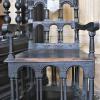Upper Gallery, 1618-19
Commentary
Thomas Bodley wisely foresaw the need for additional space for the library to expand. In 1613 he instructed that the remainder of his estate should be used to provide that ‘ouer the tops of those two stories' intended for the schools themselves ‘there shall be contriued another third rome' providing ‘a very large supplement for stowage of books when the two libraries [Duke Humphry’s and Arts End] shall be fully replenished’.* Hence the confusing designation: strictly speaking, the Schools Quadrangle is the lower two stories while the Bodleian (including Duke Humphrey’s) has always occupied the upper story. This also resulted in a quadrangle very high in proportion to its length and breadth, creating a unique and powerful impression when one enters it for the first time. Another striking feature is the contrast between the two high stories of Arts End, the three lower stories of the rest of the quad, and the five stories of the Tower.
Initially, however, the upper floor was not used as a reading room: its fenestration, determined by the schools below, was not well suited to either the storage or the reading of books. Instead. Is was known as a ‘gallery’, intended for ‘edifying perambulation’ like the long gallery of a contemporary great house. Its contents were described in 1629 by a Dutch visitor, Abram Booth, as follows.
One goes up via two staircases to a wonderfully spacious Gallery decorated with pictures of all scholars renowned to this day; furthermore, from here one enters a specially designed room of antiquities in which very old medals and many other curiosities are kept.
It retained this function for over two centuries, as shown by the engraving (Image 1) from 1829.
The painted frieze in the Gallery (painted in 1619, plastered over in 1830, and rediscovered in 1949) included portraits of 202 celebrated authors from all ages, selected it seems by Bodley himself perhaps in partnership with his first librarian, Thomas James. Together, they give a wonderfully clear picture of the theological ideas and learned values of the founder, and as such they deserve more attention here in the future.**
An impression of the rather miscellaneous collections on display can be gathered from the description penned by the Frankfurt patrician, Zacharias Conrad von Uffenbach, after a visit to Oxford in 1710.***
We were also shown a large volume with all sorts of collected engravings, amongst which were several by good artists. After this a great armchair was pointed out to us, as something very special, because it is said to have been made out of the ship in which Captain Drake sailed round the world; also several Chinese staves, bow and arrows, and again a cylinder with some vile figures. The most remarkable thing was the marble, of which Monconys speaks in his travels. It is set in a frame and hangs on the wall. The lizard or squirrel formed in it is very strange and is a white vein natural to the marble which represents this animal very prettily….
There is close by another cabinet, in which formerly Laudi Numismata [Laud’s coin collection] were kept… but the coins have been moved into the first one and unbound books put in their place…. The cabinet itself is very large and comparatively well-wrought – but old French in style like the old trésors. At the top are some large drawers, out of which Mr. Crab, with much circumstance and as if it were a sacred thing, reached down an old sword with a hilt of silver-gilt. This is said to be the one sent by Pope Leo X. to Henry VIII as Defender of the Faith. It has a large knob of crystal, which can be unscrewed and in which is painted a golden hour-glass with the word: Vigilate. Mr Crab also showed us something very curious: a gilt chain with a portrait given by the Emperor to a poet who had been crowned with laurels.
The sword given by Pope Leo X to Henry VIII is now in the Ashmolean. The Drake Chair (Images 2-3 above) is currently in the Divinity School, and provides an interesting example of the kind of curiosities originally displayed.
References
* Quotations in this and the following paragraph from John Newman, 'The Architectural Setting', Seventeenth-Century Oxford, ed. Nicholas Tyacke (Oxford, 1997), 135-77, here 152.
** The most recent study is Margaret Bullard, ‘Talking Heads: The Bodleian Frieze, its Inspiration, Sources, Designers, and Significance’, Bodleian Library Record, vol. 14 [1994], pg. 461-500, who quotes Booth on 466. The Wikipedia article lists the portraits.
*** W. H. Quarrell and W. J. C. Quarrell, ed. and trans., Oxford in 1710: From the Travels of Zacharias Conrad von Uffenbach (Oxford, 1928), 13-14.
Commentary. Howard Hotson (March 2021).

